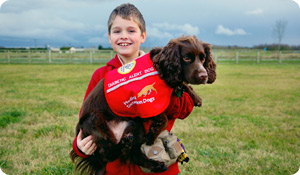
Dogs are known as man's best friend—and here's another reason why they live up to their reputation: They may be able to detect cancer.
Canine Cancer Screening
How do pups go from canine companions to diagnosis dogs? They're trained at Medical Detection Dogs, a charity in Milton Keynes, England. There, experts work in conjunction with scientists, National Health Service trusts (organizations that focus on different aspects of healthcare services), and universities to train the dogs to detect cancer in lab samples from people.
The training grew out of the efforts of Medical Detection Dogs co-founder Claire Guest, a psychologist, animal behaviorist, and the first person to teach dogs to detect cancer cells by odor. Her early studies, published in British Medical Journal in 2004, found that a group of six dogs were able to detect bladder cancer cells in urine samples 41 percent of time time—an impressive achievement, given the expected success rate of 14 percent.
The research helped Guest attract funding to form Medical Detection Dogs in 2008, and a follow up study showed that a group of four dogs had a 64 percent success rate of identifying bladder cancer cells. Currently, Medical Detection Dogs is conducting a larger-scale study examining dogs’ ability to detect prostate tumors.
How Dog Cancer Screenings Work
These detecting dogs come to a training center a few times a week to learn to sniff out the odor of volatiles (a compound produced by the cancerous cells) present in the urine and breath samples of people with different types of cancer. To keep the pups motivated, trainers use rewards-based reinforcement—like treats—and a clicker, a handheld tool that makes a noise every time a dog complies with directions.
Any breed of dog can become a cancer detector or in-home medical assistant, but they must be good with people and should be young enough to train—generally less than three years old.
Although it’s not possible to know for sure exactly what the dogs smell, since the dogs can’t communicate the specifics, the dogs are taught to sit, stand, or lie down and stare at any positive samples; this alerts researchers to them, according to Christina Bowden, PR, Marketing, and Events Manager for Medical Detection Dogs. "The dogs can detect cancer in dilutions of the equivalent of one part per trillion, which is one drop of blood in an Olympic-sized swimming pool," she notes.
Using Medical Alert Dogs to Manage Serious Conditions
The charity also provides dogs to people with potentially life-threatening conditions. These dogs use their noses to identify the changes that occur right before or during a serious medical event, such as a drop in blood sugar in a person with diabetes, or a seizure for someone with epilepsy. Dogs can even be trained to identify specific allergens in food or in the environment, which can prevent severe allergic reactions.
How does this work? Trainers expose these dogs to samples of the scent and breath taken from clients during a medical episode. This teaches the dogs what to look for. When the dogs encounter the scents they've been taught to recognize, they alert their masters by leaning or rubbing against them, or licking vigorously to get attention. Some of the dogs can even fetch needed medical supplies. For people with conditions like diabetes, epilepsy, or severe allergies, such interventions can be crucial.
People who participate in this program don’t have to pay for these alert dogs or their training, but they are responsible for the dogs' day-to-day food and living expenses.
While these wonder dogs are real heroes, they can’t replace medical screenings and regular monitoring of chronic conditions.
Researchers hope that one day they'll be able to learn just what these dogs' noses know, which could ultimately allow experts to create more effective early screening tools. In the meantime, these super sniffers are doing their best to help humans.
Christina Bowden reviewed this article.
Sources
Bowden, Christina. Medical Detection Dogs. Email interview, Feb. 10, 2016.
Willis, Carolyn M., et al. "Olfactory Detection of Human Bladder Cancer by Dogs: Proof of Principle Study." British Medical Journal 2004 712: 329.
Willis, Carolyn M., et al. "Volatile Organic Compounds as Biomarkers of Bladder Cancer: Sensitivity and Specificity Using Trained Sniffer Dogs." Cancer Biomarkers 2010-2011 8,3: 145-53. doi: 10.3233/CBM-2011-0208
"Hypoglycemia (Low Blood Glucose)." American Diabetes Association. Page last edited July 1, 2015.
Photo credit Medical Detection Dogs, Emma Jeffery.





